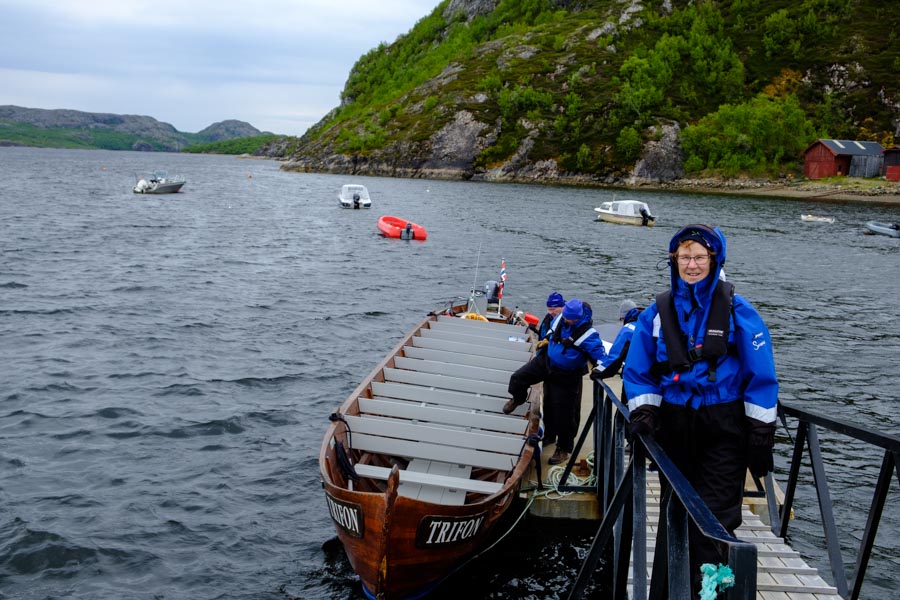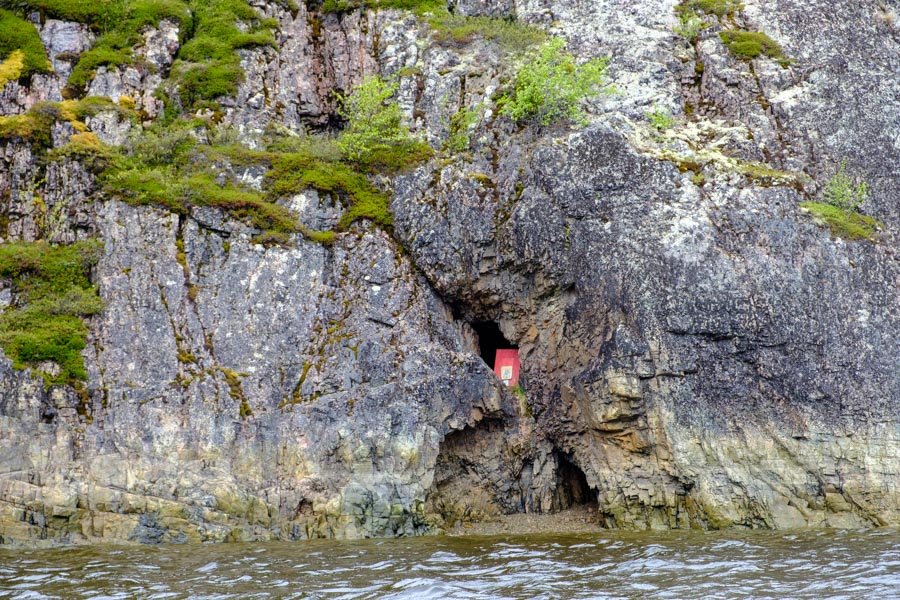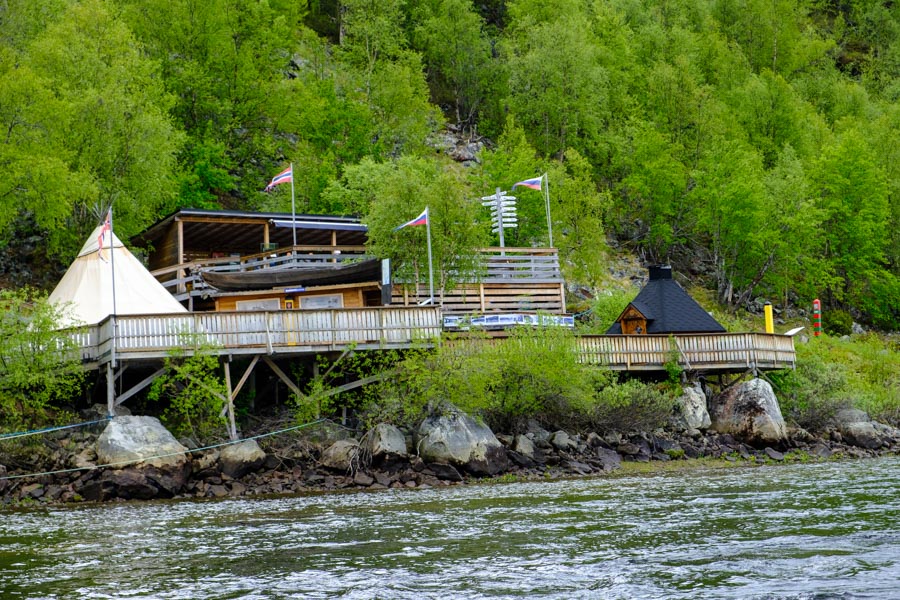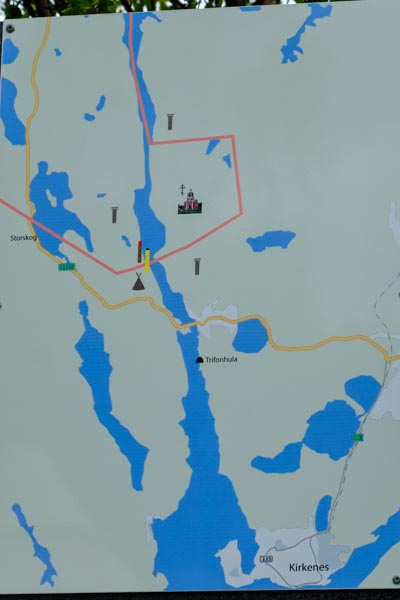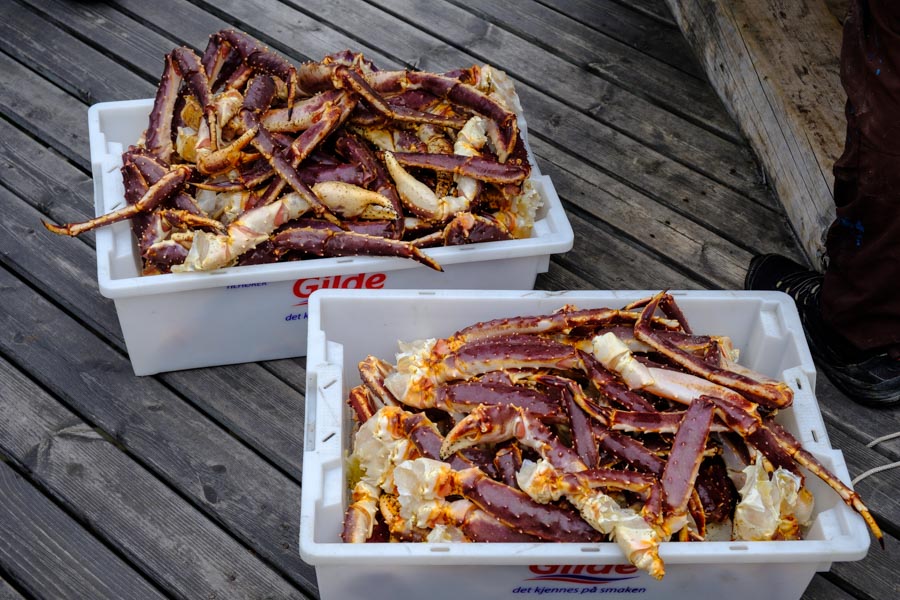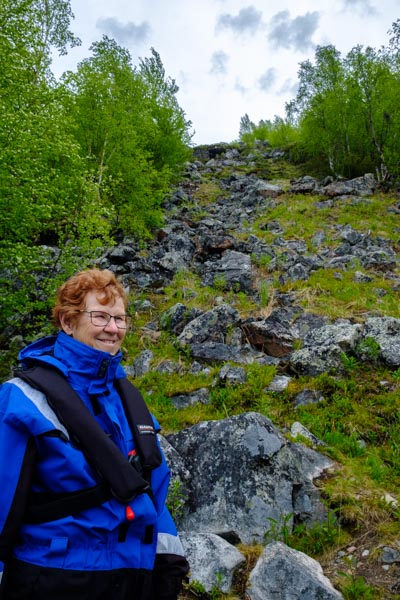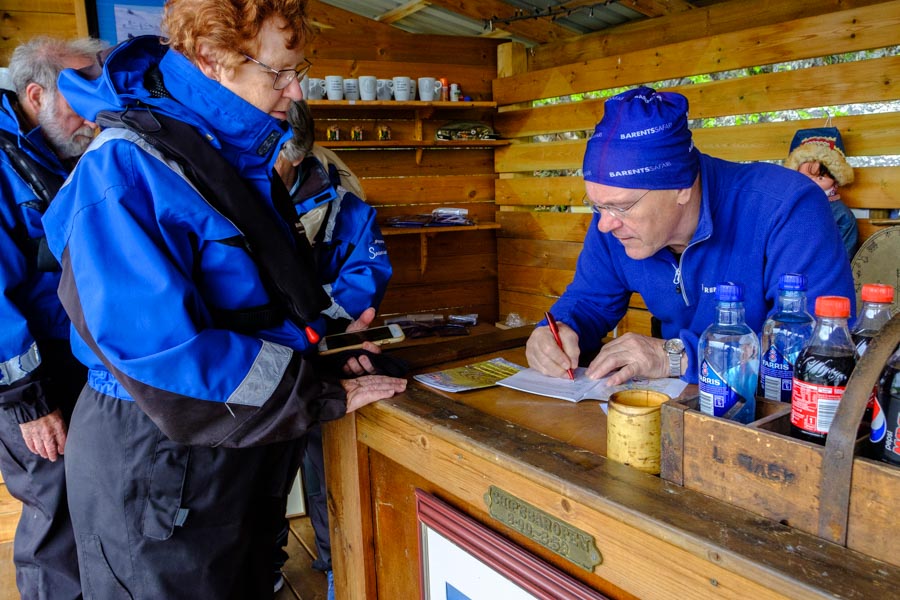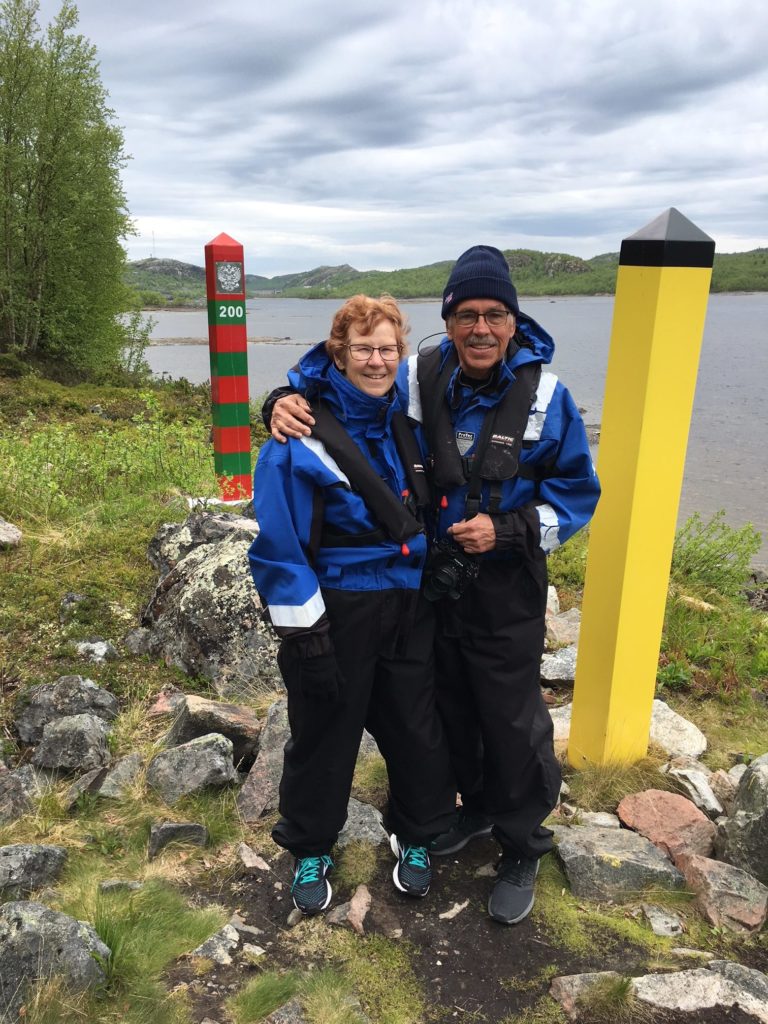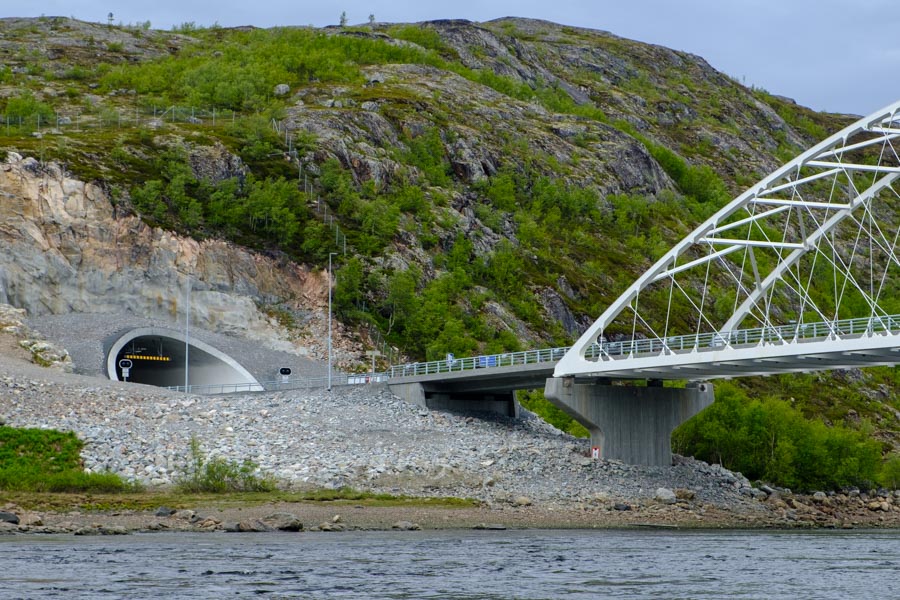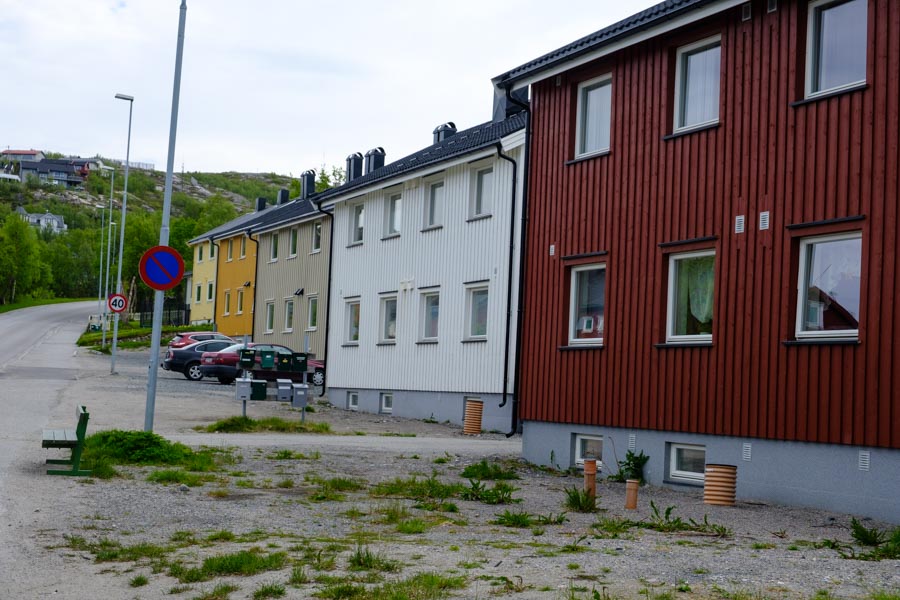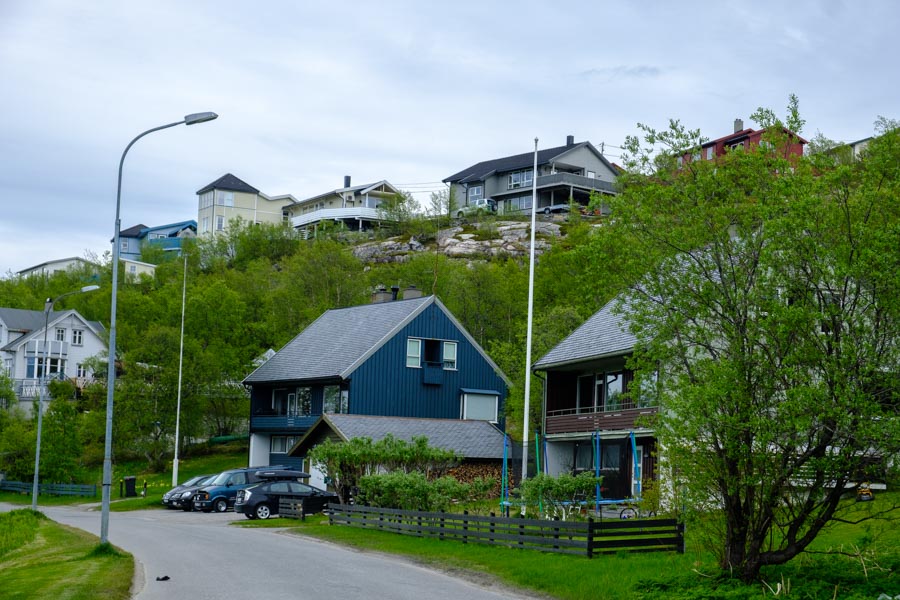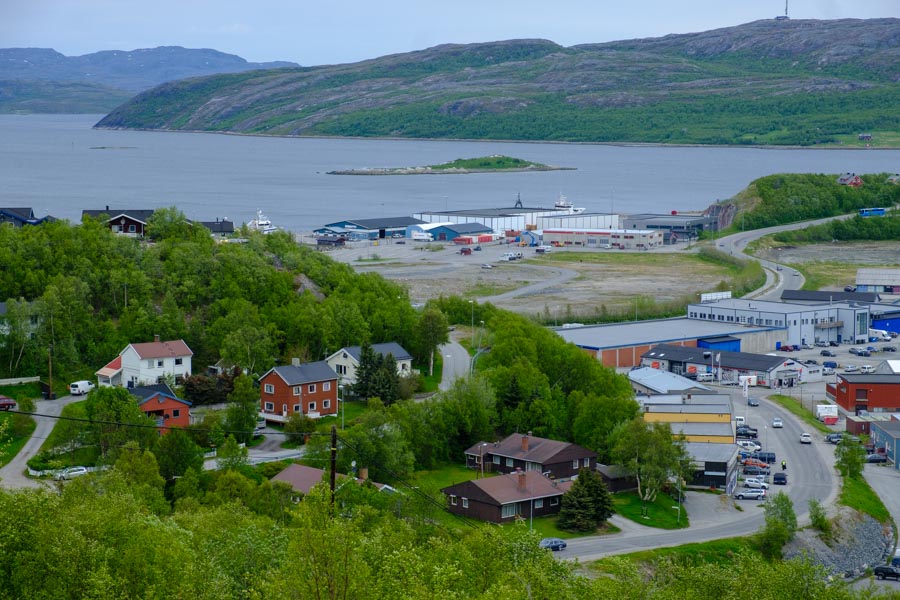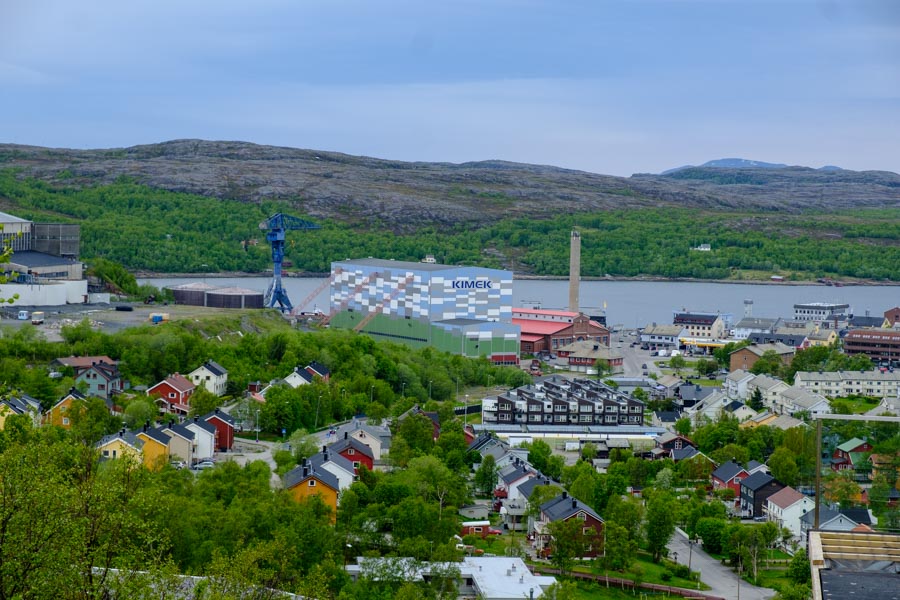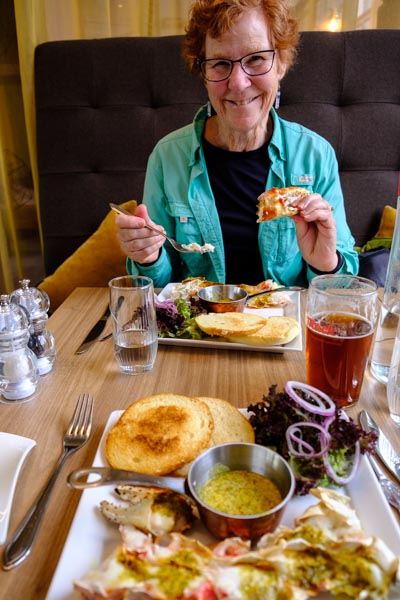We’re on our own now. No one to sound the ship chimes and tell us what to do next and no guides to show us the sights. No planned meals in the dining room at preset times. It’s all on us now.
We jumped ship about 9:30 this morning and before going totally solo we went on one last prearranged trip. It was a riverboat ride from Kirkenes to the Norwegian-Russian border, about 10 miles upstream. The boat was long and narrow, maybe 6 feet wide; there were only six of us on the trip so there was lots of room (it must hold 30 or more). The weather was chilly and overcast with spray as we motored up stream at a pretty good rate. Not much in the way of scenery although I noticed that unlike yesterday there are lots of trees. We still had the granite outcroppings but having come south overnight from North Cape we were back in a much more forgiving climate.
The Russian border where it crosses the river is marked by nothing more than a pair of posts two meters apart. The actual border is in the exact middle of the two. Our guide, Hans Hati has established a landing and a picnic platform right next to the border and overlooking the river. He showed us old pictures and told stories of the area.
It turns out there are lots of stories to tell. First, an Orthodox monk, Trifon of Pecheng, ministered to the local Sami people and converted them to Christianity long before other areas of northern Norway. One day marauders from Sweden came to plunder and to eliminate any vestige of Orthodox Catholicism; that is, they wanted to kill Trifon. He climbed down a cliff, found a small cave where he hid and so escaped his pursuers. The Samis were greatly affected by the escape of their friend and pastor. They treated the cave as a holy site, placing offerings there to bring luck in their fishing expeditions. If the fish didn’t bite they retrieved the money. Even today Trifonhula (cave of Trifon) has an icon and is the place of worship for people who come from all over Norway.
Trifon also established an Orthodox church a few miles upstream from the cave called Boris Gleb (two Russian Orthodox saints of the 12thcentury). When Norway negotiated the border with the Soviets, Stalin demanded that Boris Gleb be included in the USSR. The border that came up the center of the river did a cutout to the west to include the church. In return Norway received 50 times as much area, reaching to the Barents Sea.
There is a long complicated history of logging, fishing, tourism and conflict along the border, made difficult by Norway’s history of first Danish control, then Swedish control, the independence interrupted by WWII and Nazi occupation and then Soviet liberation. The Samis came up with the short stick in many instances, being forced at one point to cede their traditional fishing rites to others.
Today the border is observed by Norway and Russia from towers on either side of the border. Norway’s interest is to protect its territory. In fact, the border is not just a Norwegian border but also a border for Europe and NATO. They take their duty seriously. Last year a tourist visiting the border stood near the actual border between the two posts. She moved her arms in such a way as to violate the actual border. She was fined $500 by Norway, missed the Hurtigruten boat and paid $350 to catch up.
The Russians for their part are interested in making sure no Russians escape to the West. There is significant cross boarder trade: household goods bought on the cheap in Norway and resold and Russia and Russian Vodka and gasoline that is cheaper in Russia flow in the other direction.
Hans Hatie is a Sami and told us that another term for Sami is Laplander. We had learned earlier that Laplander was a derogatory term that shouldn’t be used. Hans said he had no problem with it as long as the intention isn’t racist.
So it was noon when Hans dropped us off downtown in front of the Sandic hotel. Now we were really on our own. The hotel folks checked our bags for the day for $8, resolving one question. The gal behind the desk gave us two restaurant recommendations for lunch and a couple of ideas for sightseeing until the airport bus at 7 PM.
Off we went for lunch: reindeer pasta for me and fish soup for Judy. Really delicious. As we finished our leisurely meal I looked at the map and realized that the museum we’d zeroed in on closed at 2 PM. It was now 1:45 PM. What to do?
Now Kirkenes is not exactly a tourist destination. There are king crab outings for hire but the town has no old town, now cathedral, not much of anything touristy. The museum is called the Borderland museum, indicating that the Nazi occupation took a significant toll on the city and relationships with Russia still are a factor in Kirkenes life. In fact, it’s very much a working town: lots of honest homes, mostly duplexes, but nothing fancy even on the high hillside a mile or so from downtown.
In addition to fishing Kirkenes has had until a year or two ago, a good-sized iron ore mining operation. It’s closed now but the huge buildings remain. I said to the waiter at dinner, “The closing of the mine must have been a big shock for Kirkenes’s economy.” “Not really,” he replied. “The Norwegian welfare system is so generous that no one has been seriously hurt financially. After all, the oil will run out someday soon but even then the government has saved for that future too so the welfare system can continue. Norway has a trust fund that equals 1.5% of the global stock market.”
So back to our dilemma: what to do. Our answer: hike and eat then catch the bus to the airport. So that’s what we did. We hiked up the hill to the museum just in time to see the proprietor lock the front door. We continued up the hill to two spots optimistically marked as viewpoints that should overlook the city. They did, sorta, overlook the city but the buildup of houses in the area blocked any unobstructed view.
After the big luncheon feed we weren’t exactly starving but did that stop us? Of course not. The Scandic hotel had on offer king crab dinners. So right at 5 PM we opened the place up, had our feed (really great) and polished off a couple of pieces of cloudberry cheesecake. We’ve become quite fond of cloudberries on this trip. We even visited a supermarket (a Target lookalike) and bought a jar of cloudberry jam. Come to Onawa this summer and we’ll treat you to some. Better come in July because I’m not sure it will last ‘til August.
By the way you Minnesota Lutheran friends of ours: Frozen lutefisk was selling for about 49 Kroners/KG – roughly three bucks U.S. per pound. Book your flights today. I ain’t packing it in my bag, you betcha.
Now we’re sitting in the Kirkenes airport waiting for the 8:30 departure that is now estimated to leave at 9:45. We’re looking at a two-hour flight, thirty-minute train ride and 15 minute walk to our hotel in Oslo. But who cares? Tomorrow is our last day of touring and then on Sunday we’re on our way home. And besides, we’ve been up past 1 AM for the last three nights so this won’t be much different. Blame it on the Nordkapp’s hot tub and the midnight sun!
Update: We made the bus, caught the flight (1:30 late), got our bags, found the train, got off at the correct stop, found the train station exit (with help from a nice cop), followed google maps to the hotel, checked in, schlepped our bags to our room and collapsed. It’s 1:30 AM but they serve breakfast ‘til 11 AM. Oslo, here we come!

